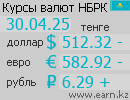About Kazakhstan

Square: 2 724 900 km²
Population: 15, 074, 2
Capital: Astana
Language: Kazakh, Russian
Religions: Islam, Christianity
Monetary unit: Kazakhstan tenge
Internet Domain: .kz
The Republic of Kazakhstan is a presidential democracy; a secular, stable and social state whose highest values are its people and their lives, rights and freedoms.
Location
The Republic of Kazakhstan lies directly between Europe and Asia, between 45° and 87° of East longitude, 40° and 55° of North latitude. It stretches from the eastern shore of the Caspian Sea and the Volga plains to the mountainous Altai and from the foothills of the Tien Shan in the south and southeast to the West Siberian lowlands in the north. The size of the territory places Kazakhstan ninth in the world, after Russia, Canada, China, USA, Brazil, Australia, India and Argentina.
In the east, north and northwest, Kazakhstan borders with China (1,460km), Kyrgyzstan (980km), Turkmenistan (380km), Uzbekistan (2,300km) Russia (6,477km). The total extent of Kazakhstan’s borders is nearly 12,200km, including 600 kilometers along the Caspian Sea in the west.

The country stretches from the lower reaches of the Volga in the west to the foothills of the Altai Mountains in the east, occupies two time zones, from the West Siberian lowland in the north to the Kyzyl-Kum desert and the mountains of Tien Shan in the south.
Climate
Remoteness from oceans and vastness of its territory determine climatic conditions. The nature of Kazakhstan impresses with its contrasts. Climate in the north of the republic is severe, Siberia, and in the south at this time could blossom apricot, turn green mountain valleys.
The average January temperature is increased from -18°C the north and east to -3°C in the southern part of Kazakhstan. The average July temperature increases from 19° Celsius in the north to +28C, +30°C in the south.
The territory of Kazakhstan is located in four climatic zones – forest-steppe, steppe, semi-desert and desert. The forest-steppe zone are the most moisture supply plains north of the republic. The shortest season is spring – 1,5 months, summer lasts 3 months, winter – from October to April.
The steppe zone occupies a vast territory in the north of the republic. It is distinguished by high wind speed. Compared with the forest-steppe zone of the duration of the winter period, less a summer – more. Spring is short, and autumn lasts less than two months. It begins in early September.
Semi-desert – is a zone of dry steppes, occupying the central part of Kazakhstan. Winter harsh and unstable weather, summers are hot.
The desert zone occupies a large part of the plain in Kazakhstan. Climate differs with long hot summers, cold winters.
Water resources
There are 8,5 thousand big and small rivers in Kazakhstan. About 80% of the territory of the republic belongs to the closed drainage of the basins and the internal flow. Irtysh, and Tobol Ishim occurring along the northern and north-east of the country, belong to the basin of the Arctic Ocean. All other major rivers in the country carry their water in the inland water body: Urals – in the Caspian Sea, the Syr Darya – the Aral Sea, Ili – in the lake Balkhash. In summer many small and medium rivers dry up.
The Caspian Sea is part of the republic of its north-eastern areas with the most fresh water and shallow depths (5-7 m). Except Kazakhstan, the Caspian Sea, owned by Russia, Azerbaijan, Iran and Turkmenistan. The Aral Sea is divided between Kazakhstan and Uzbekistan.
There are 48,000 large and small lakes in Kazakhstan. Among them are the biggest – the Aral Sea, Balkhash, Zaisan, Alakol, Tengiz, Seletengiz.
Political structure
According to the Constitution, the president is the Head of State and the Chief Executive. The highest legislative body is a two house Parliament
The population of Kazakhstan
Population – 15 million 074,2 thousand people.
Population density: 5, 5 person per 1km².
Kazakhstan – a multinational state. Kazakhstan’s population includes many ethnic groups with their cultural, linguistic and historical specificity. The largest ethnic groups are Kazakhs (45%) and Russian (35%), more than 100 are the other nationalities. Major religions are Islam and Christianity.
Language
The official language of the Republic of Kazakhstan is Kazakh, closely related to Uzbek, Kyrgyz, Turkmen and Turkish. In state institutions and local administration bodies equally the Kazakh and Russian language is used. Everyone has the right to speak their native language and to choose a language for communication, education and work that helps people of different ethnic strata to live and work in peace and harmony.
Russian is the language of international communication and is widely used in urban areas, while the principal language of the rural population is Kazakh. The Uighurs, Koreans, as well as representatives of other national minorities living in Kazakhstan, speak in their national languages and local dialects.



Culture
Kazakhs are an extremely hospitable people. If you come to a Kazakh home unexpectedly, he will be just as happy as if you had been invited. The main feature of the Kazakh national is the respect for the guests, to elders, love of peace and tolerance, which are laid in childhood. Therefore in Kazakhstan has never been ethnic and religious conflicts.
Traditions
Kazakhs are very hospitable people and love to take guests. In order to better know and get acquainted with the customs and traditions of Kazakh people we invite you to come here and see for himself.
Public holidays:
January 1,2 – New Year
March 8 – International Womens’ Day
March 22 – Nauryz Meyramy
May 1 – Kazakhstan National Unity Day
May 9 – Victory Day
June 10 – Day of the Capital
August 30 – Constitution Day
October 25 – Republic Day
December 16 – Independence Day
There are other religious holidays with varying dates:
Ramadan Khait
Kurban Khait
Kazakh national cuisine.
In the Kazakh national cuisine, as in a mirror, reflected the soul of the people, its history, customs and traditions. From ancient times, the most distinctive feature of the Kazakh people was hospitality. Guest was hearty welcomed, seated at the place of honor, were treated to the best that was in the house.
Minerals
Kazakhstan has a rich natural resources. The 105 elements of the periodic table in the bowels of Kazakhstan holds 99, 70 explored, involved in the production of more than 60 elements. At present there are 493 field, containing 1,225 kinds of minerals. In terms of mineral reserves Kazakhstan takes first place among CIS countries on the chrome ores and lead, the second – on the reserves of oil, silver, copper, manganese, zinc, nickel and phosphorus, the third – for gas, coal, gold and tin.
Kazakhstan has significant reserves of oil and gas concentrated in the western region, considering the republic as the large oil producing countries in the world. Opening of a new oil-bearing area within the South Turgay basin extends the prospects for further development of oil production of the republic.
Kazakhstan currency
National currency of Kazakhstan is the Kazakh tenge, 1 tenge = 100 tiyn. Introduced on 15 November 1993. At present, the territory of Kazakhstan participates in the cash turnover of the banknote denomination: 200 tenge, 500 Tenge, 1000 Tenge, 2000 tenge, KZT 5000, 10000 tenge. And coins: 1 tenge, 2 tenge, 5 Tenge, 10 Tenge, 20 Tenge, 50 Tenge, 100 tenge. In the Kazakh tenge 18 degrees of protection. Tenge among the most secure currency in the world

 .
.





























